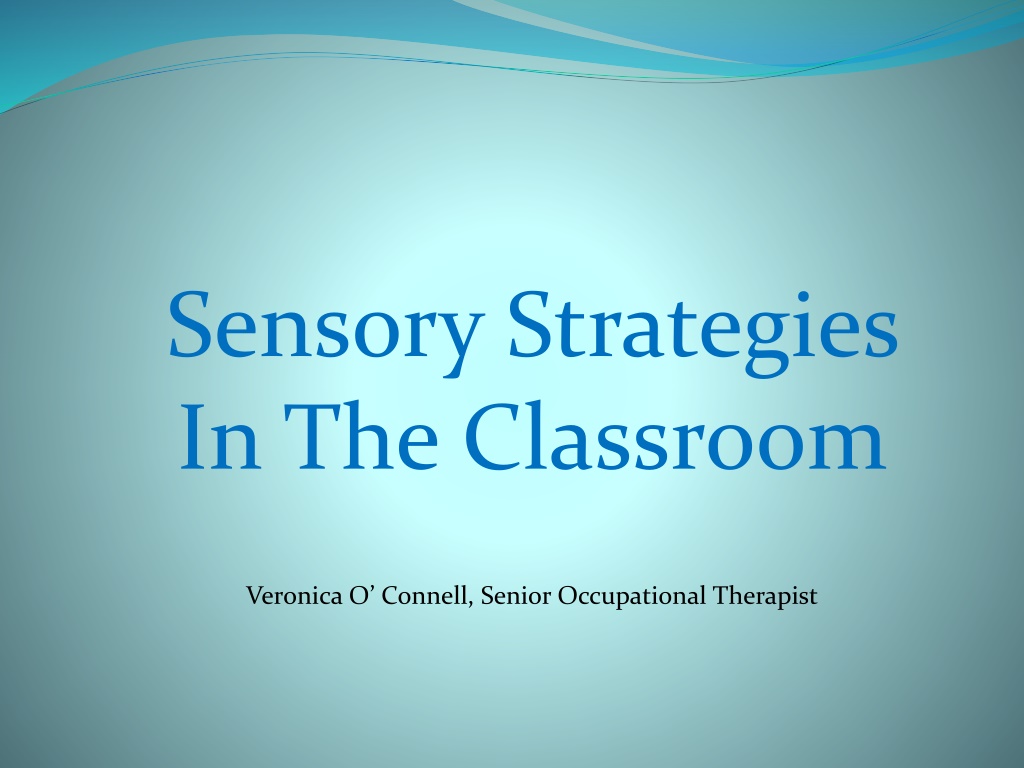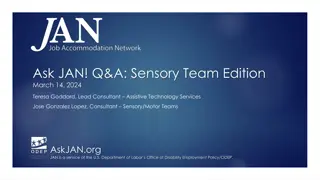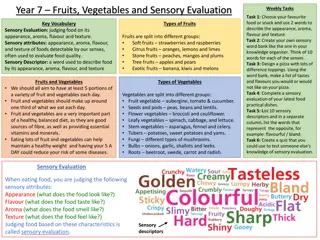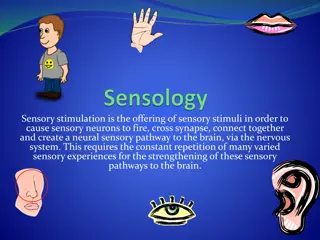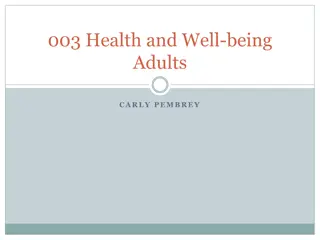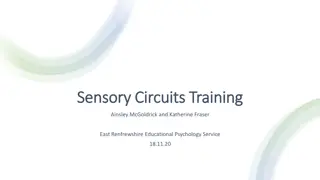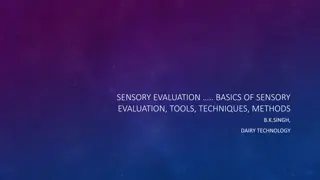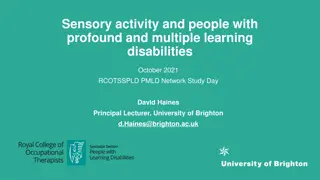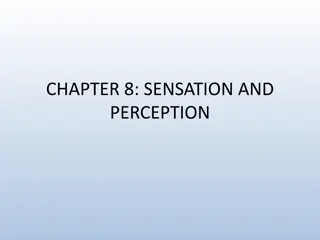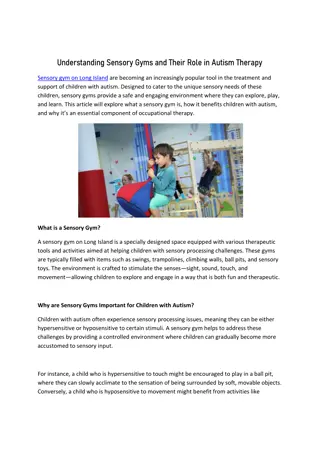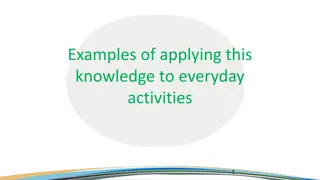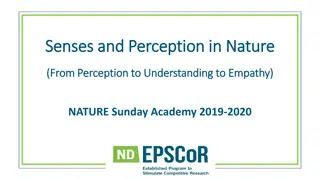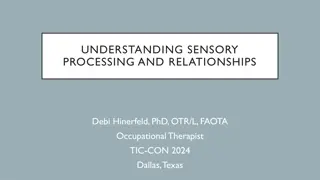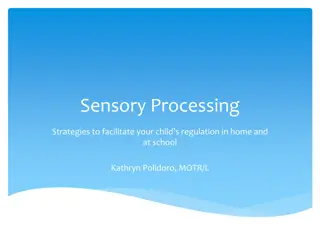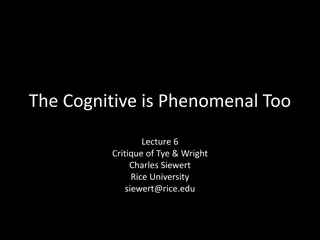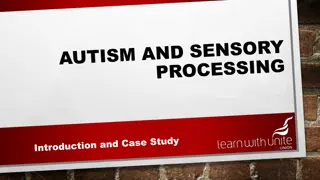Understanding Sensory Strategies in the Classroom
Explore sensory modulation and its impact on everyday activities. Gain knowledge of sensory systems, levels of alertness, and practical strategies for regulating sensory input in educational settings. Discover the hidden senses, cognitive strategies, and techniques to maintain the Just Right State for optimal function and participation.
Download Presentation

Please find below an Image/Link to download the presentation.
The content on the website is provided AS IS for your information and personal use only. It may not be sold, licensed, or shared on other websites without obtaining consent from the author. Download presentation by click this link. If you encounter any issues during the download, it is possible that the publisher has removed the file from their server.
E N D
Presentation Transcript
Sensory Strategies In The Classroom Veronica O Connell, Senior Occupational Therapist
Objectives Have a basic knowledge of sensory modulation and the senses Understand the Just Right State Have an awareness of different sensory strategies
Overview. What is sensory modulation? The sensory systems Levels of alertness Simple Strategies .
What is sensory modulation? Is the ability to regulate and organise sensory input in a graded and adaptive manner. In other words to be able to take in sensory information to generate an appropriate (or just right ) response to the situation.
What is sensory modulation? Poor sensory modulation Can therefore affect a young persons participation in everyday activities such as attention and concentration, social skills, motor coordination, organisational skills etc.
Brain Storm Activity What are the 5 senses?
The Senses Tactile (touch) Olfactory (smell) Visual (vision) Gustatory (taste) Auditory (sound)
The Hidden Senses We have 2 hidden senses that respond to sensory input inside our body Vestibular (gravity & movement) Proprioceptive (muscles and joints)
Levels of alertness / the Just Right state High or too alert Just right Low or not alert enough
The Just Right State Each of us go through varying levels of alertness on any given day. We all use a combination of cognitive strategies and sensory activities to keep us feeling just right for most of the day. We feel just right when we can interact well with others & we can participate in activities as we would like.
The Just Right State This is where we want children / adolescents to be. When they are internally feeling just right , then their minds are alert and ready to learn. They can sit in their seats and focus on what is being said to them. http://previews.123rf.com/images/dolgachov/dolgachov1601/dolgachov160101371/50369631-education-elementary-school-learning-and-people-concept-group-of-school-kids-sitting-and-listening-t-Stock-Photo.jpg
Low or not alert enough This stage describes how one might feel before having a cup of coffee /tea in the morning or Maybe how you feel when sitting in a dark, warm room for a long meeting.
Low or not alert enough How would a student present in the classroom?
This may look like Fidgeting, e.g. change position, tap leg Play with hair, play with mouth Chew pen / pencil Talking Looking around room / staring off into space Day dreaming
Too Alert This level describes how you might feel when you have 5 people talking to you at once & you ve had 3 cups of coffee. You are not able to efficiently take in the information that s being presented to you.
Too Alert? How would a student present in the classroom? http://halalfocus.net/wp-content/uploads/2014/05/question-mark-nothing.jpg
This may look like Poor attention in class Difficulty getting along with peers Described as hyper , always on the go , chatter box Frequently interrupts teacher
Protective Response People who are sensitive to sensation may respond to everyday situations/experiences with a protective response i.e.- flight, freeze, fight, vigilance, because their sensory system perceives it as threatening.
Which may look like Flight- run! constant movement, avoidance of particular situations Freeze- don t move, quiet, withdrawn or express fear out of proportion to situation Fight- confront the possible danger, irritable, aggressive, heavy handed Vigilance- on alert: hearing over-sensitive, distractible, poor eye contact, fidgety
The sensory systems Each sensory system has sensations that usually alert the system and sensations that usually calm. As a general rule sensations that are rhythmical, predictable and slow are calming Sensations that are fast, arrhythmic and unpredictable are alerting.
Question?? Is it alerting or calming? Taking a shower Taking a bath Being tickled Getting a hug Listening to loud music
In the classroom Inhibition Top down inhibition versus Bottom up inhibition
In the classroom Need to utilise bottom up inhibition through sensori- motor strategies http://nobacks.com/wp-content/uploads/2014/11/Light-Bulb-38.png
Simple Strategies GOAL: REMAIN REGULATED. Children / Adolescents if their nervous system is in a Just Right state, they will be in a better position to maintain attention, engage discussion and complete school work.
Tools for the mouth Food Items: In general, foods that are alerting tend to be cold, sour/tart, spicy, minty, or crunchy Foods that are calming tend to be warm, smooth, or sweet Some foods fall under heavy work (for the jaw and cheek muscles) which can either calm or alert
Image result for Ark's Krypto Bite Necklace Tools for the mouth Non Food Options: Straws Theratubing / krypto bite necklace Chewy Tubes ChewEase Pencil Top Blow Pens Whistles/Blow Toys Blowing Cotton Balls Image result for Ark's Pencil Topper - Blue XXT Image result for chewease pencil topper
Tools for the body (Ways to move) Try different seating options: Movin sit/disc o sit cushion A therapy ball Allowing children to stand at their desks and work (often putting a piece of tape on the floor where they should stand/stay helps).
Tools for the body Up and down motions: Skipping, dunking a basketball, bouncing on a gym ball, pogo stick, lolo ball or marching Front and back activities: Rocking in a chair, swinging, roller blading Upside down activities: Hanging on bars, wheelbarrow walking, tumbles, head stands Crash and bump activities: Jumping into piles of pillows or on an old mattress, driving bumper cars, pillow fights, playing football Circles: Sit n spins, merry-go-round, spinning on a tire swing, riding on a ferris wheel
Heavy Work Heavy work is the performance of tasks that involve heavy resistance and input to the muscles and joints: - pushing - pulling - lifting - carrying - moving heavy items - stretching
Tools for the hands (Touch) Weighted blanket/snake Lap weights Hand fidgets - therapy putty, string, paperclips, stress balls, koosh balls Rice/sand play Finger paints Funny foam Hand cream/moisturiser
CartoonEyes1.jpg Tools for the eyes Try dimming the lights and closing the blinds to calm Muted colours and plain walls tend to be calming Bright colours, busy walls, bright lights and art work tend to be alerting or distracting
CartoonEyes1.jpg Tools for the eyes Tips to reduce distractions: Secure art work, maps and graphics on the wall so that they don t flutter Tack a sheet over open shelves to cover art materials/games/toys etc Remove mobiles swinging from light fixtures Adjust window blinds to prevent light from flickering through Consider positioning of the student in the classroom setting Provide low distraction area e.g. a study booth Cardboard template
Tools for the ears Sounds that are short, arrhythmic, loud, or novel tend to be alerting Sounds that are rhythmical, quiet, long in duration, and familiar are calming and easier to ignore Try using music of various types and volumes to change alertness levels Create cozy corners where students can be when the noise is overwhelming
Tools for the ears For students who are sensitive to noise, let them use earplugs or headphones in the cafeteria or assemblies During tests let students wear headphones (with no sound) /earplugs to help block out distractions Tennis balls on bottom of chairs Position student away from loud noises (e.g. window, air conditioning)
Just Right Environment What changes can you make to your classroom
Reference Information Check out the Alert Program website: www.alertprogram.com Ayer,A.J. (1979). Sensory integration and the child. Los Angeles: Western Psychological Services. Williams, M.S. & Shellenberger, S. (1994). How does your engine run? A leader s guide to the Alert Program for self- regulation. Albuquerque, NM: TherapyWorks, Inc. Williams, M.S. & Shellenberger, S. (2001). Take 5! staying alert at home and school. Albuquerque, NM: TherapyWorks, Inc. Drive Thru Menus Calming and Stress Busting Kit by Tere Bowen-Irish www.therapro.com
